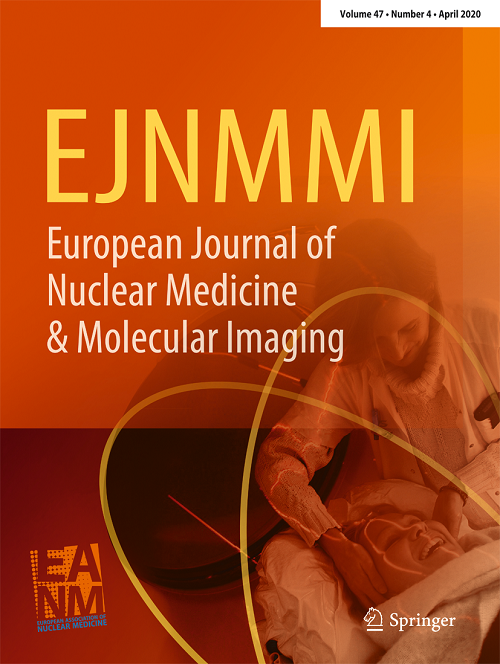Multitracer comparison of gold standard PSMA-PET/CT with 68Ga-FAPI and 18F-FDG in high-risk prostate cancer: a proof-of-concept study.
IF 7.6
1区 医学
Q1 RADIOLOGY, NUCLEAR MEDICINE & MEDICAL IMAGING
European Journal of Nuclear Medicine and Molecular Imaging
Pub Date : 2025-05-27
DOI:10.1007/s00259-025-07352-6
引用次数: 0
Abstract
PURPOSE The aim of this study was to, evaluate the diagnostic accuracy of [⁶⁸Ga]Ga-FAPI-46 positron emission tomography (PET)/computed tomography (CT) in high-risk prostate cancer (PC) compared to [¹⁸F]PSMA / [⁶⁸Ga]Ga- PSMA- and [¹⁸F]FDG- PET/CT as well as multiparametric magnetic resonance imaging (MRI). MATERIALS AND METHODS Ten patients with high-risk PC (PSA > 20 ng/mL, Gleason score > 7, or > T2c) underwent PET/CT imaging using [⁶⁸Ga]Ga-FAPI-46, [¹⁸F]F-/[⁶⁸Ga]Ga-PSMA and [¹⁸F]FDG before radical prostatectomy (RP). The maximum standardized uptake values (SUVmax) were measured for the entire prostate and individual prostate sextants. Diagnostic accuracy was assessed per patient and per segment by correlating imaging findings with final histopathologic results. Immunohistochemical analysis of PSMA and FAP expression was performed on the index tumor lesion. RESULTS Histopathologic analysis confirmed pT2c and pT3 prostate adenocarcinoma in 4 (40%) and 6 (60%) patients, respectively. One patient (10%) had regional lymph node metastasis (pN1). The International Society of Urological Pathology (ISUP) grade groups (GGs) were 2 (60%), 3 (20%), and 5 (20%). Overall, 46 of 60 prostate sextants were histologically positive for PC. While PSMA expression was detected in all patients, FAP expression was observed in 5 of 9 cases (55.5%). Per-patient and per-segment analyses demonstrated that [⁶⁸Ga]Ga-FAPI-46 and [¹⁸F]F-/[⁶⁸Ga]Ga-PSMA had comparable diagnostic accuracy and outperformed [¹⁸F]FDG. The mean (SD) SUVmax of the entire prostate was highest for PSMA PET/CT at 13.1 (7), followed by FAPI at 7.6 (5.5) and FDG at 5.4 (3.5) (p = 0.015). Among patients in the FAPI subgroup, those with ISUP GG 3-5 exhibited greater FAP expression and radiotracer uptake compared to ISUP GG 2 cases. In the two high-grade patients, [⁶⁸Ga]Ga-FAPI-46 demonstrated greater tumor uptake than [¹⁸F]PSMA / [⁶⁸Ga]Ga-PSMA PET/CT. Notably, MRI demonstrated higher diagnostic accuracy and superior local staging compared to all radiotracers evaluated. CONCLUSION FAP expression was detected in a subset of high-risk PC patients, particularly in those with higher-grade disease. This proof-of-concept study may suggest a role for [⁶⁸Ga]Ga-FAPI-46 PET/CT in primary PC with low PSMA avidity, but further research is warranted to define its clinical application.黄金标准PSMA-PET/CT与68Ga-FAPI和18F-FDG在高危前列腺癌中的多示踪剂比较:一项概念验证研究。
目的比较[⁶⁸Ga]Ga- fpi -46正电子发射断层扫描(PET)/计算机断层扫描(CT)与[¹⁸F]PSMA /[⁶⁸Ga]Ga- PSMA-和[¹⁸F]FDG- PET/CT以及多参数磁共振成像(MRI)对高危前列腺癌(PC)的诊断准确性。材料与方法10例高危PC患者(PSA为>0 ng/mL, Gleason评分为> 7或> T2c)在根治性前列腺切除术(RP)前采用[⁶⁸Ga]Ga- fpi -46、[¹⁸F]F-/[⁶⁸Ga]Ga- psma和[¹⁸F]FDG进行PET/CT成像。测量了整个前列腺和单个前列腺六分仪的最大标准化摄取值(SUVmax)。通过将成像结果与最终的组织病理学结果相关联来评估每个患者和每个节段的诊断准确性。对指标肿瘤病变进行PSMA和FAP表达的免疫组化分析。结果4例(40%)pT2c前列腺癌,6例(60%)pT3前列腺癌。1例(10%)有局部淋巴结转移(pN1)。国际泌尿病理学会(ISUP)分级组(GGs)分别为2(60%)、3(20%)和5(20%)。总的来说,60个前列腺六分仪中有46个在组织学上为前列腺癌阳性。所有患者均有PSMA表达,9例患者中有5例(55.5%)有FAP表达。单患者和单节段分析表明,[⁶⁸Ga]Ga- fapi -46和[¹⁸F]F-/[⁶⁸Ga]Ga- psma具有相当的诊断准确性,优于[¹⁸F]FDG。PSMA PET/CT的全前列腺平均SUVmax (SD)最高,为13.1(7),其次是FAPI 7.6(5.5)和FDG 5.4 (3.5) (p = 0.015)。在FAPI亚组患者中,与ISUP GG 2患者相比,ISUP GG 3-5患者表现出更高的FAP表达和放射性示踪剂摄取。在两例高级别患者中,[26⁸Ga]Ga- fapi -46比[¹⁸F]PSMA /[26⁸Ga]Ga-PSMA PET/CT表现出更大的肿瘤摄取。值得注意的是,与所有评估的放射性示踪剂相比,MRI显示出更高的诊断准确性和优越的局部分期。结论fap在高危PC患者亚群中有表达,特别是在疾病级别较高的患者中。这概念验证研究可能表明一个角色(⁶⁸Ga) Ga-FAPI-46 PET / CT在初级PC贪欲PSMA较低,但进一步的研究是必要的来定义它的临床应用。
本文章由计算机程序翻译,如有差异,请以英文原文为准。
求助全文
约1分钟内获得全文
求助全文
来源期刊
CiteScore
15.60
自引率
9.90%
发文量
392
审稿时长
3 months
期刊介绍:
The European Journal of Nuclear Medicine and Molecular Imaging serves as a platform for the exchange of clinical and scientific information within nuclear medicine and related professions. It welcomes international submissions from professionals involved in the functional, metabolic, and molecular investigation of diseases. The journal's coverage spans physics, dosimetry, radiation biology, radiochemistry, and pharmacy, providing high-quality peer review by experts in the field. Known for highly cited and downloaded articles, it ensures global visibility for research work and is part of the EJNMMI journal family.

 求助内容:
求助内容: 应助结果提醒方式:
应助结果提醒方式:


